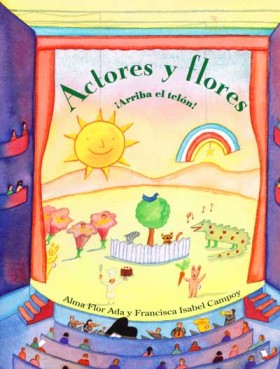
BOOK DESCRIPTION
This anthology contains six plays appropriate for students in second to fifth grade.
Two of the plays were originally created by Alma Flor Ada and Isabel Campoy: La cuchara de palo is a new version of the traditional tale Stone Soup while El árbol is a dramatic game, in which children will pretend to be a tree. As they read or say the lines they can experience all the gifts a tree offers and internalize that they, as the trees, have much to offer. La mata de guayabas by Clara Rosa Otero is a dramatization of a Latin American trickster’s tale. Tamarindo el pastelero, a humorous play by Beatriz Dourmec. The final selection, Los colores, is a poem to be dramatized, written by the well-loved Puerto Rican poet Isabel Freire de Matos.
CHILDREN’S THEATRE
The values of the use of involving children with theatre are multiple. Plays can be an excellent tool for promoting the ability to speak in front of a group, which is a leadership skill. Since they offer children the opportunity to utilize words and language registries they may not have other opportunity to use, plays can be strong vehicle for vocabulary and language development.
When used for choral reading plays can strengthen reading skills. In addition, acting on a play enhance children’s self-confidence and self-esteem while providing opportunities to learn about one’s self and others. Most importantly, putting out a play, no matter how simply, promotes the values of collaboration and solidarity.
AUTHOR’S NOTE
Theatre has been a passion in my life. I was part of every play during my school years and later in High School I also begun writing plays. One of my works “The Museum” was chosen to be performed at the important theatrical event of our class graduation. Theatre was a way of life for me during those early years.
Because of my experience with theatre, and how important it was in giving me a voice, breaking the barriers of shyness, and encouraging me to speak in public; ensuring that children have access to read and act in plays has always been one of my basic goals. Even if it is done with great simplicity, acting in a play can have very positive results.
I am convinced that one is better able to teach something one has enjoyed doing. And just as Alma Flor Ada and I emphasize, in our courses of Authors in the Classroom, that teachers who create their own books will be better able to get their students to become authors, I believe that encouraging teachers to do theatre and experiencing the richness of the process would better allow them to incorporate plays in their regular teaching.
ABOUT THE CIELO ABIERTO THEATRE COLLECTION
Each of the seven anthologies in this series offers a variety of plays well-suited for either reading aloud or for full-scale performance. For the early grades, Alma Flor Ada and F. Isabel Campoy have created original adaptations of traditional children’s stories. Familiar tales are retold in the form of plays, choral poems, and theatre games, inviting children to explore movement, characterization, and imaginative play. The use of traditional Hispanic folklore, woven into the dialogue, enhances the cultural setting in which the stories have been recast. For the older grades, a selection of the best plays written for children throughout the Spanish-speaking world has been carefully assembled.
The anthologies are:
- Primer acto [PreK-2] 48 pages
- Risas y aplausos [K-3] 48 pages
- Escenas y alegrías [1–4] 48 pages
- Actores y flores [3–6] 64 pages
- Ensayo general [4–7] 80 pages
- Saludos al público [5–8] 96 pages
- Acto final [5–8] 96 pages